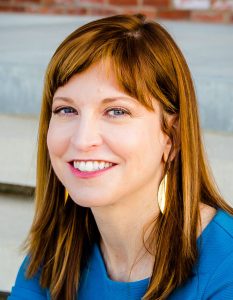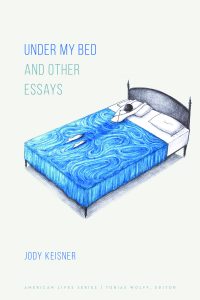How Writing A Memoir-in-Essays Saved My First Failed Book
How Writing A Memoir-in-Essays Saved My First Failed Book
By Jody Keisner
 When people ask me how long it took to write Under My Bed and Other Essays, I tell them five years, but that isn’t the whole story. I had to write and fail at another book for seven years first. (Twelve years total, but who’s counting?) Bloated scene after bloated scene of my memories filled my first book—even if they weren’t particularly memorable—because I mistakenly believed that’s how I was supposed to write. “Show Don’t Tell,” was the writing maxim I clung to then.
When people ask me how long it took to write Under My Bed and Other Essays, I tell them five years, but that isn’t the whole story. I had to write and fail at another book for seven years first. (Twelve years total, but who’s counting?) Bloated scene after bloated scene of my memories filled my first book—even if they weren’t particularly memorable—because I mistakenly believed that’s how I was supposed to write. “Show Don’t Tell,” was the writing maxim I clung to then.
Rather than explicitly telling readers what I wanted them to know or exploring how I felt or what I thought, I tried to show them through scenic construction, action, dialogue, and sensory details and descriptions. And if they didn’t figure it out from all my showing? Too bad, I guess? I arranged everything chronologically, even if a different arrangement would’ve made more connections thematically. In essence, I was writing what I (mistakenly) thought of as a traditional memoir.
Memoir comes from the French mémoire, which means “memory.” A memoirist excavates significant memories from their life to make sense of their life circumstances or create a portrait of their lifestyle. The attention memoirists pay to the details of their worlds—and to what these details mean—is exquisite. Entire bedrooms, neighborhood blocks, city streets, and countries and the people and animals who populate them come to life on their pages. Their stories are full of transformation and tender or hard-won insight that occurs after major conflict and turning points in their lives. Successful memoirists write stories that are vulnerable, introspective, and engrossing.
I wasn’t a successful memoirist. In addition to my overreliance on scene and lack of self-reflection, my narrative voice was falsely cheerful, ignoring the melancholy that had so often filled the years I was writing about. I pushed for happy resolution, where in real life there hadn’t been any yet. The book wasn’t intellectually truthful, either, and—most problematically—was devoid of what made me me: my curiosity for an idea and where it might lead and my tendency to turn to research to understand the things in life that baffled or intrigued me or caused me to sit straight up in bed at night. Everything about the book felt wrong on a gut-level, but I pressed on. After querying two agents—one of whom had been reluctantly encouraging—I finally stashed the manuscript underneath my sweaters in a dresser drawer.
When I started writing the second book over three years later—during which time I’d turned my attention to academic writing and standalone essays—I set out to do the opposite of what I’d done the first time. I didn’t pursue my memories, instead following the lead of my dark-of-the-night thoughts and my self-questioning. I soon discovered I was writing a book about fear and how I and other women and mothers experience it. When my ideas reached a dead end in my prose, I turned to data. My research into science, psychology, religion, and pop culture enriched and added nuance to the personal stories and memories I did write about and helped expand their meaning and reach toward the universal. One example, I learned that the hypervigilance and worrying I’d experienced as a new mother is in part due to brain changes that occur during pregnancy and that are so profound some scientists refer to the phenomenon as “brain remodeling.” Through research I was able to broaden my attempt to understand the implications of my mother-fears.
Essay comes from the French infinitive essayer, “to try” or “to attempt.” A personal essay is the author’s attempt to make order and sense of her ideas and thoughts. It’s almost as if the memories are secondary: used to illustrate, examine, analyze, and turn over an idea, but the ideas themselves are the heartbeat of the book. Chapters in a memoir-in-essays are connected by theme or a central narrative thread but not necessarily linked by memories and their relationships to each other in time or subject, as is often the case with memoirs. Essayists might ask the same question or probe the same dilemma repeatedly, but from different vantage points and in different contexts. They acknowledge the complexity in their story but don’t necessarily find resolution in the same way memoirists do.
That liminal space, between contemplation and memory, is where my voice was. That’s where I was, too: the once nerdy girl and now nerdy woman who loves reading traditional memoirs as much as she loves reading a science-based article on the maternal brain and pregnancy. As an essayist, I felt free to time travel, write within experimental structures, and get under the skin, to the stuff of neural pathways and gray brain matter. None of this is to say that one subgenre of creative nonfiction is superior to the other or that these characteristics I’ve described are mutually exclusive; memoirs share characteristics with essays and vice-versa. Further, I mined several chapters from my first failed book for material in my second since the facts of my childhood remain unchanged. Only when I felt free to look beyond the borders of my lived experience, however, did I begin to write my truth.
—
Jody Keisner is the author of Under My Bed and Other Essays, a memoir about the roots of violence and fear that afflict women and mothers, starting with the working-class Midwestern family she was adopted into and ending with her own experience of mothering daughters. She is a writer, teacher, mother, first-generation college graduate, and ex-waitress. Her work has appeared or is forthcoming in Los Angeles Review of Books, Brevity, The Normal School, Literary Mama, Fourth Genre, AARP, and many other journals and magazines. You can find her at www.jodykeisner.com or on Twitter @JodyKeisner.
About Under My Bed and Other Essays (University of Nebraska Press, American Lives Series, September 1, 2022):
 Fear is a profound and personal experience, but we all share a common fear: that we or our children and loved ones will be hurt. We know that fear, like pain, is inevitable, yet we hope it away. Or we confront it. Does fearing keep us safe or make us weak? What—or who—should we fear? We build barriers between us and our fears, and then we wonder: will they be enough? Growing up in rural towns in Nebraska, Jody Keisner is raised by a volatile father and kind but passive mother. As a young adult living alone for the first time, she begins a nighttime ritual of checking under her bed each night, not sure who she’s afraid of finding. An intruder? A monster? Her father?
Fear is a profound and personal experience, but we all share a common fear: that we or our children and loved ones will be hurt. We know that fear, like pain, is inevitable, yet we hope it away. Or we confront it. Does fearing keep us safe or make us weak? What—or who—should we fear? We build barriers between us and our fears, and then we wonder: will they be enough? Growing up in rural towns in Nebraska, Jody Keisner is raised by a volatile father and kind but passive mother. As a young adult living alone for the first time, she begins a nighttime ritual of checking under her bed each night, not sure who she’s afraid of finding. An intruder? A monster? Her father?
Now a wife and mother, her fears have matured and the boogeyman under the bed has shape-shifted, though its shapes are no less frightening—a young aunt’s drowning, the “chest chomp” in the classic horror movie The Thing, a diagnosis of a chronic autoimmune disease, the murder of a young college student, an eccentric grandmother’s belief in reincarnation and her dying advice: “Don’t be afraid.”
In essays both literary and experimental, Keisner illustrates the tension between the illusion of safety, our desire for control, and our struggle to keep the things we fear from reaching out and pulling us under.
Category: How To and Tips
























Very timely advice – thank you. I’ll continue writing both scenes and essays and see what shape they make.
Loved reading Jody Keisner’s post about her latest book, Under my Bed and Other Essays.